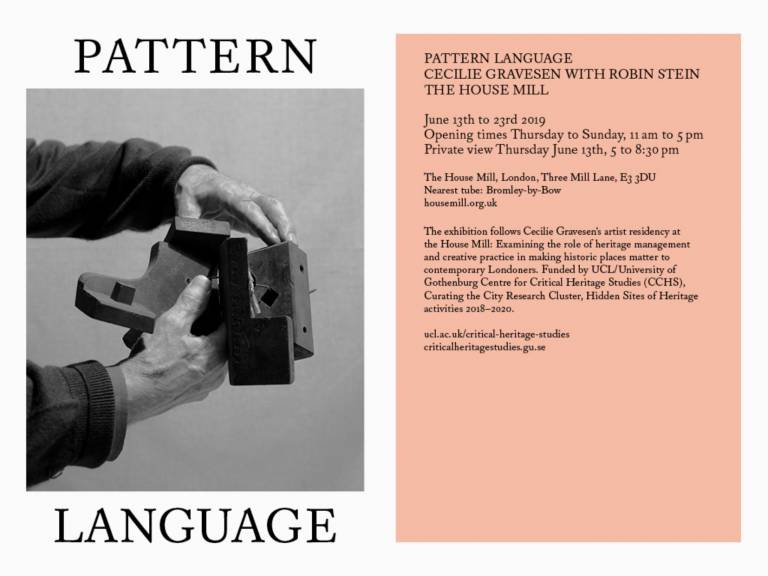Art exhibition Pattern Language at the Mill
13 June 2019–23 June 2019, 11:00 am–5:00 pm

The exhibition Pattern Language explores a unique collection of historical industrial patterns at East London’s House Mill
Event Information
Open to
- All
Availability
- Yes
Organiser
-
Cecilie Gravesen
Location
-
The House Mill3 Mill LaneBromley-by-BowE3 3DU
The exhibition Pattern Language explores a unique collection of historical industrial patterns at East London’s House Mill, and tests the objects as tools for interaction between the Mill and its
neighbourhood, currently undergoing rapid changes of re-development.
Visual Artist Cecilie Gravesen has invited local people to handle the patterns, captured in a new work made in collaboration with the American photographer Robin Stein. In suggesting that these unique, sensory objects could become a ‘language’ to communicate across cultural divides, the project playfully ignites an idea that might endure in people’s relationships with the Mill.
The exhibition title is a tribute to Christopher Alexander’s celebrated Pattern Language, an architectural tool for community-based design solutions originated in the 1970’s that recognizes ‘civic’ intelligence in creating meaningful places. During the exhibition, Cecilie is engaging conservators to construct a group of object loan boxes in the gallery, and this will allow selected patterns to travel out of the Mill in the future.
The House Mill is the world’s largest surviving tidal mill. This well kept secret is hidden in plain sight, across a busy highway, isolated on a man made island, and between the boroughs of Newham and Tower Hamlets, in an area of intense ethnic diversity and high economic disadvantage. First mentioned as a flourishing mill site in the Domesday Book of 1086, the current grade 1 listed building dates back to 1776, and has a history as a major gin producer.
Deep inside the Mill is the hidden collection of more than two thousand custom made mechanicalpatterns, largely unknown to visitors and stored on bulging shelves. Once used for castingreplacement components to keep the Mill’s machinery working, the light wooden objects are now covered by thick layers of dust.
The artists’ book Pattern Language, has been produced on occasion of the exhibition. Printed at Circadian Press, New York and Designed, it includes writing by Dr. Dean Sully, Institute of
Archaeology, UCL, alongside photographs by Gravesen and Stein, and is designed by Anna Rieger.
The exhibition concludes Cecilie Gravesen’s artist residency in The House Mill, funded by the research cluster Curating the City - UCL/University of Gothenburg Centre for Critical Heritage Studies (CCHS). It examined the role of heritage management and creative practice in making historic places matter to contemporary Londoners.
http://www.ucl.ac.uk/critical-heritage-studies and https://criticalheritagestudies.gu.se/
THE HOUSE MILL, THREE MILL LANE, LONDON E3 3DU
http://www.housemill.org.uk
About the artists:
Cecilie Gravesen is a visual artist working with films, installations and ‘situations’ in interpretive and experimental documentary. Through spending time with objects and the people who care for them, her work reflects on material culture as a vehicle for social transformation, and on creative engagement with heritage. She is Honorary Research Associate with UCL Institute of Archaeology and exhibits regularly.
Robin Stein is a photographer and filmmaker making work in the fine art, editorial and commercial realms. His work frequently looks towards the historical human influence on the landscape and built environment in proximity to waterways. He has exhibited widely and has produced editorial content for publications including The New York Times T magazine, WSJ Magazine, Vogue and Wallpaper.
Links:
Photo credit: Cecilie Gravesen and Robin Stein, Pattern Language 2019
Author: Jenny Hogstrom Berntson
Article published for: criticalheritagestudies.gu.se
 Close
Close

